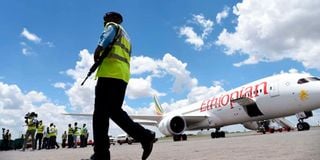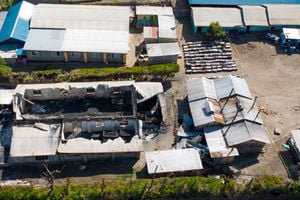Kenya, EAC partners to pilot open skies policy

A police officer walks past an Ethiopian Airline plane at the Jomo Kenyatta International Airport, Nairobi, on March 24, 2020.
What you need to know:
- Open skies policy in civil aviation means easing access to national airports for foreign airlines to increase the flow of tourists and develop their potential as regional air hubs.
- This will see airlines from Kenya, Uganda, Tanzania, Rwanda, and other EAC states operate across borders without restrictions.
The East African Community (EAC) will pioneer the open skies policy for aviators in Africa as part of a strategy to grow tourism and trade on the continent, an industry association has said.
Open skies policy in civil aviation means easing access to national airports for foreign airlines to increase the flow of tourists and develop their potential as regional air hubs.
“The reason we chose EAC is that the states are already in advanced stages of harmonising various aspects of policy on issues to do with taxes and charges. We want to look on now going into the aspect of air transport liberalisation,” said Maureen Kahonge, the business development and communications senior manager at the African Airlines Association (Afraa).
This will see airlines from Kenya, Uganda, Tanzania, Rwanda, and other EAC states operate across borders without restrictions, hence increasing traffic and reducing ticket prices.
Stakeholders across different aviation sectors in Africa, during a conference in Nairobi early this month, resorted to testing the opening up of African skies as a way of growing business.
Single Air Transport Market
Noting that the level of intra-Africa air connectivity remained low with a market share of African airlines falling from 3.5 per cent of global traffic in the 1980s to 1.9 per cent by last year, the players committed to starting a journey towards the Single Africa Air Transport Market (SAATM).
Africa’s aviation industry has for more than two decades expressed the need to operate a SAATM to remain sustainable, but reluctance by states to open up the skies has left them struggling.
Afraa notes that many African states have maintained restrictions that have made it difficult for airlines from other countries to operate and this leaves all of them making losses, despite a commitment by 45 states to implementing Saatm since 2018.
Countries mainly restrict operations of airlines from other states through denial of some traffic rights, particularly the fifth freedom, which enables an airline to carry passengers between destinations outside its home country.
“Many times, some states are not authorising this fifth freedom. And even for third and fourth, which are bilateral, sometimes there are restrictions in terms of the number of flights,” says Afraa secretary-general Abderahmane Berthe.
Afraa says after bringing air transport service providers together, the key issues on the table include discussing bilateral agreements, with a long-term vision of removing restrictions altogether.
Regulatory text on dispute resolution mechanism, which has held states back from issuing air traffic freedoms, is expected to be finalised this year to spur issuance of more rights.
Many African states have been operating on a bilateral basis, failing to liberalise the market even as other regions around the world opened up their skies by removing restrictions, a move linked to the growth of intra-region business and traffic, which reflects on airlines’ revenues.
Afraa also blames African governments for reluctance to implement decisions they have committed to ensuring the air transport industry is open, mainly to protect state carriers.
The association has been pushing for opening up of the skies and lowering of taxes and charges, moves it argues will grow traffic for operators in the air transport industry by attracting more travellers as the market gets competitive and brings down ticket prices.
It expects the implementation of SAATM to be on course by 2025.
“To develop air transport in Africa, we need to go for consolidation because we cannot have so many operators in the continent. It will not work. We need to have global operators who are inter-regional operators.”
African airlines continue to be impacted by the Covid-19 pandemic with the latest projections from Afraa showing they are expected to lose up to $4.1 billion in revenues this year, after losing a total of $18.9 billion in 2020 and 2021.
By May, recovery was still on course, albeit slow, with capacity in terms of the number of seats offered by the airlines at 76 per cent of 2019 levels and connectivity at 74 per cent.
“We can see that business and leisure travels are re-starting and even in some airports across Africa passenger congestions are being witnessed, with flights delayed because there are a lot of passengers and flights. It’s good to see the industry recovering,” Mr Berthe said.
Workers shortage
But he added that the recovery has also come along with another challenge with airlines running short of workers, a consequence of actions to lay off thousands of workers when the pandemic hit in 2020.
The entire travel industry lost about half of its workforce across the continent, Afraa states.
“Many airlines laid off their staff and in this industry staff need to be certified before starting work, which takes time. Most of the people laid off founded businesses in other sectors and they don’t want to come back to the airline industry and others found new jobs,” Mr Berthe said.





